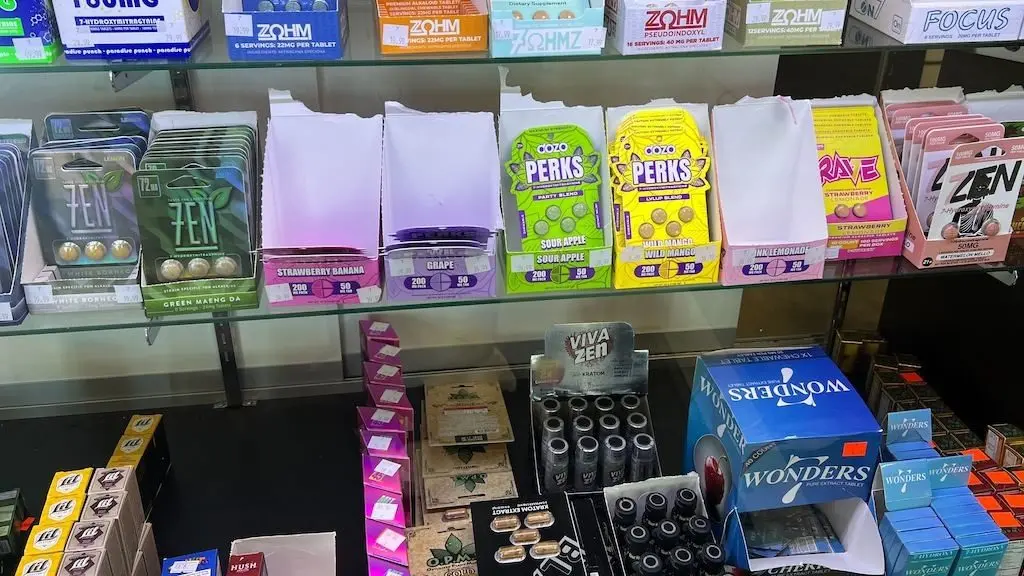Washington, D.C. State legislators have been in charge of regulating kratom, a contentious herbal supplement used to treat pain, anxiety, and the symptoms of opioid withdrawal, for many years. Some states have outright prohibited it. Others have enacted legislation mandating lab testing, labeling, and age restrictions.
The District of Columbia and at least half of the states have passed regulations pertaining to kratom or its constituents, creating a patchwork of laws centered on a commodity that the federal government has mostly ignored.
However, that might soon change. 7-hydroxymitragynine, or 7-OH, is a potent substance that is present in trace amounts in kratom and is occasionally synthesized or concentrated in items that are sold online, in smoke shops, or behind gas station counters. The U.S. Food and Drug Administration is working to outlaw it.
Last month, federal health officials declared that the molecule should be included in the Schedule I banned substances list, along with heroin and LSD, due to the significant health dangers it poses to the public.
Federal officials’ approach to kratom, which they tried to outlaw in 2016, has changed significantly as a result of this action. The change’s potential effects on the expanding 7-OH business and its customers have also generated discussion.
At least seven states have introduced legislation this year to strengthen kratom laws, including calls for labeling requirements, age restrictions, and prohibitions.
According to federal officials, addiction medicine experts, and kratom researchers, kratom, which comes from the leaves of a Southeast Asian tree, can have a variety of mental and physical consequences. Although kratom is frequently taken in combination with other narcotics, reports of accidental overdosing have surfaced in recent years.
Despite being different products with different markets, 7-OH and Kratom are closely related. While kratom has been around for decades, 7-OH, a semi-synthetic chemical made from it, only came to market in late 2023.
This is an impending public health emergency.
Christopher R. McCurdy, University of Florida medicinal chemistry professor
Prominent experts on kratom agree that further study is necessary to completely comprehend the long-term impacts of consuming both drugs.
Unfortunately, there are a lot of things we don’t know about, according to Christopher R. McCurdy, a University of Florida medicinal chemistry professor. McCurdy, a pharmacist by training, has spent more than two decades researching kratom.
According to research, kratom doesn’t seem to induce severe withdrawal on its own and may even help with opioid withdrawal. While higher dosages may have sleepy, opioid-like effects, smaller amounts appear to have stimulating properties. According to McCurdy, very little is known regarding the dangers of long-term use in people.
Although 7-OH hasn’t been explored in people, it has the potential to relieve pain and may be very addictive. McCurdy told Stateline that researchers are still unsure of the safe dosage and frequency of use.
Leading authorities on kratom concur that both kratom and 7-OH ought to be regulated, but they warn that putting 7-OH under a rigid Schedule I classification would make research much more difficult. Instead, they contend that it should be placed under Schedule II, like some other opioids.
According to a 2023 federal poll, approximately 1.6 million Americans aged 12 and up took kratom in the year prior to the research. Between 11 million and 16 million Americans are predicted by the American Kratom Association, a national industry lobbying group, to safely take kratom products annually in 2021.
7-OH has been used in an increasing variety of items as it became more and more popular in recent years. Many customers, particularly those who are new to kratom, occasionally don’t comprehend the differences between goods, according to several academics and addiction medicine specialists.
It is comparable to selling morphine or oxycodone at a smoke shop or gas station since it is a pure opioid that is accessible without a prescription, McCurdy added. This is an impending public health emergency.
Citing a significant potential for misuse, the U.S. Department of Health and Human Services suggested in late July that the federal Drug Enforcement Administration list 7-OH in Schedule I. Kratom leaves or powders containing naturally occurring 7-OH would not fall under this classification.
During a news conference, FDA Commissioner Marty Makary stated that we are not targeting ground-up or leaf kratom. Our aim is an opioid, a potent synthetic byproduct.
Makary admitted that insufficient data and studies are available to completely comprehend the potential impact or prevalence of 7-OH use. However, he stated that the Trump administration is determined to take robust and proactive measures to address the problem before it becomes a more significant public health issue.
States impose harsher fentanyl sanctions in spite of public health concerns.
Although the kratom plant only contains trace amounts of 7-OH naturally, federal officials have expressed worry about U.S. goods that include concentrated or synthesized forms of the chemical because it is more potent than morphine and principally responsible for the opioidlike effects of kratom.
The DEA, which is in charge of the last stages of the procedure, such as releasing a formal proposal and starting a public comment period, will now consider the FDA’s request to schedule 7-OH.
If the rule is finalized, it may have an impact on customers in places where enhanced kratom products are now allowed as well as businesses that sell those products.
In 2016, the DEA retracted its scheduling of kratom compounds because to strong public protest.
Kirsten Smith, an assistant professor of behavioral sciences and psychiatry at Johns Hopkins University who is researching the effects of kratom on humans, expressed surprise at the FDA’s attempt to schedule 7-OH.
She told Stateline, “At this time, we don’t really have a public health signal of a lot of adverse events for either kratom or for 7-OH.” To be honest, I was always shocked that kratom was given priority when it came to scheduling. I’m not sure if we currently have data to support scheduling.
However, other advocacy organizations, such as the Holistic Alternative Recovery Trust, contend that the kratom industry is attempting to stifle competition from 7-OH products by arguing that the movement to schedule 7-OH is motivated more by corporate interests than public health.
According to Jeff Smith, the group’s national policy director, who has used 7-OH for pain and sleep relief, “We believe that this is just happening because the legacy kratom manufacturers are losing market share and want to create a crisis with this.”
Members of his group are concerned that the federal government’s action may push the market underground or encourage individuals to use riskier substances, even though they advocate regulation and safe consumption.
“It has had a significant impact on my life,” Smith stated. With so much promise for this product to help people, we believe it would be awful to cut it off based on such a lack of facts.
The increasing use of kratom and 7-OH products by teenagers and young people is a major worry, according to federal health officials.
There are little restrictions on where or how these items are offered, and several officials and addiction medicine experts have noted that they frequently include tastes and packaging aimed at younger consumers. Products containing kratom and 7-OH are sold at gas stations or online in states with unclear laws, occasionally without any age verification.
According to Socorro Green, a prevention specialist with Youth180, a nonprofit organization in Dallas that focuses on preventing youth substance use, “as you walk into a gas station, even though it’s behind the glass, it’s kind of eye level, and it has all these bright colors, it has all these things that really attract the visual of a kiddo.”
Green went on to say that young people in rural areas, where convenience stores and gas stations are frequently the only available retailers, would have even easier access to kratom and 7-OH products.
Certain items may not precisely or clearly reveal their 7-OH content, according to some experts and researchers, and are occasionally mislabeled as traditional kratom.
Some States Ban Kratom as Use Increases
In response, some states, counties, and towns have increased the minimum buying age to 18 or 21 or banned kratom. However, enforcement is still uneven in many places, and some addiction experts believe that more precise federal and state regulations are required, particularly as more people turn to kratom and 7-OH to treat their own pain, anxiety, or withdrawal symptoms.
According to Terrence Walton, the executive director and chief executive officer of NAADAC, the Association for Addiction Professionals, there must be some sort of oversight, including a mechanism to help guarantee that individuals are aware of what they’re taking.
This year, at least seven states have either considering or passed kratom-related legislation, ranging from complete prohibitions to labeling requirements and age limitations.
Legislators in New York passed two bills: one that raised the minimum purchasing age to 21 and required warning labels, banning the labeling of kratom products as all-natural. The governor has not received either.
In Colorado, a new law that was passed into law in May forbids the sale of kratom in kid-friendly or candy-like forms, expands labeling regulations, restricts 7-OH concentrations, and outlaws the production and sale of synthetic or semi-synthetic kratom.
The minimum age to purchase kratom in Mississippi was raised to 21 by a new law that went into effect in July. Additionally, synthetic kratom extracts and items containing high levels of 7-OH are prohibited. This year, lawmakers in Texas and Montana offered identical bills, but not one moved forward.
The most recent state to prohibit kratom was Louisiana, which did so on August 1. Rhode Island, however, was the first state to lift its ban in July. Set to go into effect in April 2026, the new law creates a regulated framework for the production, distribution, and sale of kratom products.
As of this year, kratom is prohibited in seven states: Alabama, Arkansas, Indiana, Louisiana, Rhode Island (until April 2026), Vermont, and Wisconsin, as well as Washington, D.C. Today, kratom or its constituents are regulated in at least half of the states in the United States.
Amanda Hernández, a reporter for Stateline, can be contacted at [email protected].
Statelineis part of States Newsroom, a nonprofit news network supported by grants and a coalition of donors as a 501c(3) public charity. Editorial independence is upheld by Stateline. Contact Editor Scott S. Greenberger for questions:[email protected].












